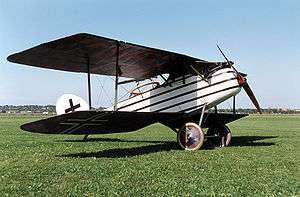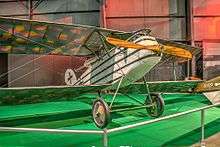Halberstadt CL.IV
The Halberstadt CL.IV was a German ground attack aircraft of World War I.
| Halberstadt CL.IV | |
|---|---|
 | |
| Role | Ground Attack Aircraft |
| Manufacturer | Halberstädter Flugzeugwerke |
| Designer | Karl Thies |
| Introduction | 1918 |
| Primary user | Luftstreitkräfte |
Design and development
Karl Thies, chief designer of the Halberstädter Flugzeugwerke, G.m.b.H., designed the CL.IV as a replacement for the CL.II. As the CL.II had proven to be particularly effective in the ground support role, the focus of an improved version was to create a specific ground attack aircraft.
The new CL.IV featured a shorter, strengthened fuselage and a horizontal stabilizer of greater span and higher aspect ratio than that of the CL.II. These changes, along with a one-piece, horn-balanced elevator, gave the CL.IV much greater maneuverability than its predecessor. After tests were completed of the prototype in April 1918, at least 450 were ordered from Halberstadt, and an additional 250 aircraft from a subcontractor, LFG (Roland), as Halberstadt CL.IV(Rol).
Operational history
The Halberstadt CL.IV was one of the most effective ground attack aircraft of World War I, relying on its good maneuverability to avoid ground fire. It appeared on the Western Front towards the end of the German offensives in 1918. Flights of four to six aircraft flew close support missions, at an altitude of less than one hundred feet, suppressing enemy infantry and artillery fire just ahead of the advancing German troops. After these late German offensives stalled, Halberstadt CL.IVs were used to disrupt advancing Allied offensives by striking at enemy troop assembly points and night sorties were also made against Allied airfields.
Towards the end of the war, on bright, moonlit nights, CL.IV squadrons attempted to intercept and destroy Allied bombers as they returned from their missions.
Operators
- Lithuanian Air Force: 12 aircraft (No. 9432, 5814, 5831, 5909, 5915, 5920, 5937, 6589, 8176, 8192, 9409, 9486)[2]
- Polish Air Force: 3 aircraft[3]
Specifications
.jpg)

Data from German Aircraft of the First World War[5]
General characteristics
- Length: 6.54 m (21 ft 5 in)
- Wingspan: 10.74 m (35 ft 3 in)
- Height: 2.67 m (8 ft 9 in)
- Wing area: 27 m2 (290 sq ft)
- Empty weight: 728 kg (1,605 lb)
- Gross weight: 1,068 kg (2,355 lb)
- Powerplant: 1 × Mercedes D.III 6-cylinder water-cooled in-line piston engine, 120 kW (160 hp)
- Propellers: 2-bladed fixed-pitch propeller
Performance
- Maximum speed: 165 km/h (103 mph, 89 kn)
- Endurance: 3 hours 15 minutes
- Time to altitude: 5,000 m (16,404 ft) in 32 minutes
Armament
References
- Notes
- Gerdessen 1982, p.76
- Pirmieji karo aviacijos lėktuvai 1919-23 m., http://www.plienosparnai.lt/page.php?81
- Morgała, Andrzej (1997). Samoloty wojskowe w Polsce 1918-1924. Warsaw: Lampart. ISBN 83-86776-34-X, pp.118-119, 295
- Grosz, Peter M. (1994). Halberstadt Cl.IV, Windsock Datafile no. 43, Albatros Productions, ISBN 0-948414-58-8, pp.4,12
- Gray and Thetford 1962, p. 142.
- Bibliography
- Gerdessen, F. "Estonian Air Power 1918 - 1945". Air Enthusiast No 18, April - July 1982. Pages 61–76. ISSN 0143-5450.
- Gray, Peter and Thetford, Owen. German Aircraft of the First World War. London: Putnam, 1962.
External links
| Wikimedia Commons has media related to Halberstadt CL.IV. |